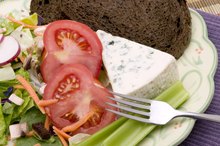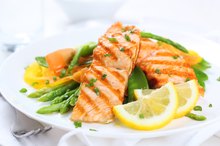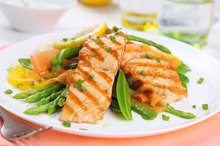Foods That Cause Tendonitis
Tendonitis is a painful swelling in a tendon and surrounding tissues, and common examples of this overuse injury include tennis elbow, Achilles tendonitis in runners and wrist tendinitis from typing. Causes may be from poorly designed workspaces, overtraining or bad athletic technique, but some foods may increase your likelihood of tendonitis because it is an inflammatory disease. A healthy diet can lower your inflammation.
If you are experiencing serious medical symptoms, seek emergency treatment immediately.
Fatty Meats
Fatty meats and full-fat dairy products may increase your risk for tendonitis because of their high amounts of saturated fat and cholesterol, which raise your levels of chronic inflammation, according to the Linus Pauling Institute Micronutrient Information Center 15. Seafood may further reduce your risk for tendonitis because of its long-chain omega-3 fatty acids.
Caloric Beverages
Foods That Make Psoriasis Worse
Learn More
Obesity is a risk factor for tendonitis because it increases stress on your joints. Caloric beverages can lead to weight gain because their calories are not very filling compared to calories from solid foods. and Department of Health and Human Services; Dietary Guidelines for Americans; January 2010').
Refined Grains
Eating too many refined grains could potentially lead to tendonitis because of their high glycemic index, which means they can cause spikes in your blood sugar levels after you eat them. A high-glycemic diet can increase your inflammation and risk for tendonitis and also lead to weight gain and diabetes.
Sweets
Can Eating Too Much Fruit Cause Gout?
Learn More
Candies and baked goods, such as:
- cakes
- cookies
- pastries,
- ice cream
- may increase your risk for tendonitis because they are sources of empty calories
A risk of eating high-calorie foods that do not contain many essential nutrients is that you may gain unwanted weight. Also, these foods may take the place of healthy foods that contribute anti-inflammatory nutrients to your diet. For example, anti-inflammatory nutrients in fruits and vegetables include vitamin C, carotenoids and dietary fiber.
Related Articles
References
- Linus Pauling Institute Micronutrient Information Center; Inflammation; Victoria J. Drake, Ph.D.
- U.S.D.A. and Department of Health and Human Services; Dietary Guidelines for Americans; January 2010
- Linus Pauling Institute Micronutrient Information Center; Glycemic Index and Glycemic Load; Jane Higdon; December 2005
- Cleveland Clinic. Tendinitis. Updated February 23, 2015.
- Lopez RG, Jung HG. Achilles tendinosis: treatment options. Clin Orthop Surg. 2015;7(1):1–7. doi:10.4055/cios.2015.7.1.1
- Ling SK, Lui TH. Posterior tibial tendon dysfunction: an overview. Open Orthop J. 2017;11:714–723. doi:10.2174/1874325001711010714
- Schwartz A, Watson JN, Hutchinson MR. Patellar tendinopathy. Sports Health. 2015;7(5):415–420. doi:10.1177/1941738114568775
- Chianca V, Albano D, Messina C, et al. Rotator cuff calcific tendinopathy: from diagnosis to treatment. Acta Biomed. 2018;89(1-S):186–196. doi:10.23750/abm.v89i1-S.7022
- Vaquero-Picado A, Barco R, Antuña SA. Lateral epicondylitis of the elbow. EFORT Open Rev. 2017;1(11):391–397. doi:10.1302/2058-5241.1.000049
- Skinner TM. Intersection Syndrome: The subtle squeak of an overused wrist. J Am Board Fam Med. 2017;30(4):547-551. doi:10.3122/jabfm.2017.04.170053
Writer Bio
Natalie Stein specializes in weight loss and sports nutrition. She is based in Los Angeles and is an assistant professor with the Program for Public Health at Michigan State University. Stein holds a master of science degree in nutrition and a master of public health degree from Michigan State University.









